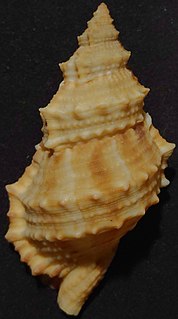Black sigatoka is a leaf-spot disease of banana plants caused by the ascomycete fungus Mycosphaerella fijiensis (Morelet). Also known as black leaf streak, it was discovered in 1963 and named for its similarities with yellow Sigatoka, which is caused by Mycosphaerella musicola (Mulder), which was itself named after the Sigatoka Valley in Fiji, where an outbreak of this disease reached epidemic proportions from 1912 to 1923.
Mycosphaerella musicola is a fungal plant pathogen, which is the causal agent of Yellow Sigatoka leaf spot disease on banana plants.

Amblyseius is a large genus of predatory mites belonging to the family Phytoseiidae. Many members of this genus feed on other mites such as red spider mites, and also on thrips. Several species are popular as biological control agents to control these pests.
Berthelinia fijiensis is a species of a sea snail with a shell comprising two separate hinged pieces or valves. It is a marine gastropod mollusk in the family Juliidae.

Conasprella fijiensis is a species of sea snail, a marine gastropod mollusk in the family Conidae, the cone snails and their allies.

Terebra fijiensis is a species of sea snail, a marine gastropod mollusk in the family Terebridae, the auger snails.

Bursina fijiensis is a species of sea snail, a marine gastropod mollusk in the family Bursidae, the frog shells.
Amblyseius ampullosus is a species of mite in the family Phytoseiidae.
Amblyseius andersoni is a species of mite in the family Phytoseiidae. It is found in Europe.
Ecsenius fijiensis is a species of combtooth blenny in the genus Ecsenius. It is found in coral reefs in the western central Pacific ocean, around the Fiji Islands. It can reach a maximum length of 3.9 centimetres. Blennies in this species feed primarily off of benthic algae and weeds.

Amblyseius tamatavensis is a species of mite in the family Phytoseiidae.
Gnathothlibus fijiensis is a moth of the family Sphingidae. It is known from Fiji.
Copelatus fijiensis is a species of diving beetle. It is part of the genus Copelatus of the subfamily Copelatinae in the family Dytiscidae. It was described by Félix Guignot in 1955.
Bascanichthys fijiensis is an eel in the family Ophichthidae. It was described by Alvin Seale in 1935. It is a tropical, marine eel which is known from Fiji, in the western central Pacific Ocean.

Lethacotyle fijiensis is a species of monogeneans of the family Protomicrocotylidae.
Typhlodromips swirskii, the Swirski mite, is a species of predatory mite in the family Phytoseiidae. It is used in biological pest control of western flower thrips in greenhouse or indoor grown crops.
Caldanaerobius fijiensis is a thermophilic, obligately anaerobic and spore-forming bacterium from the genus of Caldanaerobius which has been isolated from a hot spring in Fiji.
Aspergillus fijiensis is a species of fungus in the genus Aspergillus. It belongs to the group of black Aspergilli which are important industrial workhorses. A. fijiensis belongs to the Nigri section. The species was first described in 2011. It has been isolated from soil in Fiji and from Lactuca sativa in Indonesia. This species is able to grow at 37 °C, and produces asperparalines and okaramins.





